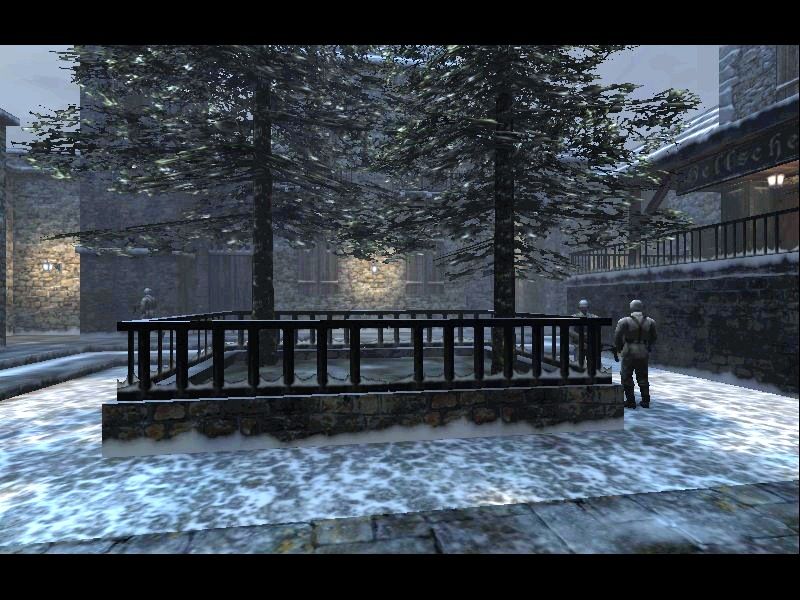Retro Replay Review
Gameplay
Return to Castle Wolfenstein delivers a tight, satisfying first-person shooter experience that balances frantic combat with moments of stealth and exploration. Players step into the boots of B.J. Blazkowicz, navigating dimly lit hallways, secret passages, and outdoor compounds while uncovering Nazi occult experiments. The arsenal at your disposal is varied—ranging from the classic Luger and MP40 submachine gun to heavier weapons like the flamethrower, Mauser sniper rifle, dynamite, and grenades. This variety encourages players to experiment with different loadouts depending on the mission.
(HEY YOU!! We hope you enjoy! We try not to run ads. So basically, this is a very expensive hobby running this site. Please consider joining us for updates, forums, and more. Network w/ us to make some cash or friends while retro gaming, and you can win some free retro games for posting. Okay, carry on 👍)
The game’s level design is one of its standout strengths. Each mission is carefully crafted to include multiple pathways, hidden rooms, and secret switches. Whether you choose to go in guns blazing or take a quieter approach, the pacing feels natural and immersive. Objectives are often multilayered, pushing you to infiltrate enemy camps, sabotage occult laboratories, and retrieve crucial intelligence without getting overwhelmed by enemy patrols or supernatural threats.
On top of the single-player campaign, Return to Castle Wolfenstein offers a robust multiplayer mode that pits Axis against Allies in objective-based maps. Roles and weapons differ depending on your faction, and classic modes like “Search & Destroy” and “Capture the Flag” offer hours of replayability. The community mods and dedicated servers that sprang up around launch only enhanced longevity, making the multiplayer component a core reason to revisit the game even after completing the story.
Graphics
Powered by id Software’s id Tech 3 engine, Return to Castle Wolfenstein was a graphical powerhouse at its release. The game’s lighting system creates hauntingly realistic corridors, flickering torches, and sudden shadows that heighten tension with every turn. Character models boast detailed uniforms, expressive faces, and fluid animations that bring enemy soldiers and monstrous creations to life.
Environments range from cold, stone-walled dungeons to snowy mountain strongholds and sprawling courtyards, each rendered with attention to architectural authenticity. The occult laboratories feature macabre decorations—ritual altars, eerie symbols, and bubbling vats—that reinforce the supernatural theme. Texture quality remains solid on modern hardware, though some dated assets may reveal their age when viewed up close.
Particle effects for explosions, gunfire, and flamethrower streams still pack a punch, while the game’s gore system emphasizes visceral feedback without feeling gratuitous. Water reflections, dynamic shadows, and weather effects such as drifting snow add atmospheric depth. Though not as polished as contemporary shooters, Return to Castle Wolfenstein’s art direction ensures it stands out as visually memorable even decades later.
Story
The narrative thrust of Return to Castle Wolfenstein begins with the chilling capture of two Allied agents investigating Nazi occult activities within the fortress. One agent is brutally tortured to death, setting a grim tone before B.J. Blazkowicz breaks free by dispatching a guard and embarking on a mission of vengeance and revelation. This opening sequence immediately immerses players in high stakes and personal resolve.
As Blazkowicz advances, he uncovers Heinrich Himmler’s SS Paranormal Division, intent on resurrecting the ancient Saxon warlord Heinrich I. The story’s supernatural bent—rituals, summoned demons, and monstrous constructs—provides a fresh twist on the World War II setting. Brief cutscenes and in-game documents reveal the zealotry and desperation fueling the Nazis’ dark experiments, lending weight to your mission beyond mere battlefield skirmishes.
Voice acting and sound design amplify the sense of dread, from distant chanting echoing through empty halls to the piercing screams of tortured victims. The interplay between historical references and occult fiction maintains narrative momentum, offering enough twists to keep players invested until the final showdown. While the story doesn’t shy away from classic shooter tropes, its blend of history and horror earns it a distinct identity.
Overall Experience
Return to Castle Wolfenstein remains a benchmark for story-driven shooters that blend historical settings with supernatural elements. Its campaign length strikes a balance between depth and pacing, offering roughly 10–15 hours of gameplay depending on difficulty and exploration. Replay value is bolstered by hidden secrets, alternate routes, and the highly replayable multiplayer component.
Over two decades after its release, the game’s mechanics may feel slightly archaic compared to modern shooters, but its core gameplay loop—looting ammo, clearing rooms, uncovering secrets—still delivers excitement. Community patches and high-resolution texture mods can refresh the visuals, while dedicated online servers keep multiplayer alive. For players seeking a classic FPS with a dark, occult twist, this remains an essential experience.
In summary, Return to Castle Wolfenstein offers a memorable campaign, atmospheric graphics, and a compelling story that blends history and horror. Its multiplayer mode extends longevity, and the overall package has aged gracefully thanks to solid design fundamentals. Whether you’re a veteran of the series or new to B.J. Blazkowicz’s adventures, this game is a worthwhile addition to any shooter enthusiast’s library.
 Retro Replay Retro Replay gaming reviews, news, emulation, geek stuff and more!
Retro Replay Retro Replay gaming reviews, news, emulation, geek stuff and more!









Reviews
There are no reviews yet.